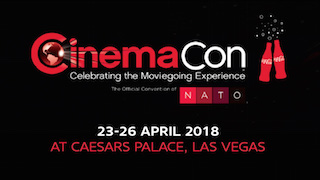 Each year, Digital Cinema Report presents the Catalyst Award to the best new technology introduced at CinemaCon, the annual convention of the National Association of Theatre Owners. At this year’s show, held April 23-26 at Caesar’s Palace in Las Vegas, people from more than seventy countries gathered to discuss the latest issues, trends and technologies in motion picture distribution and exhibition. One technology trend stood out. For many reasons, until now, event cinema has been an exhibition afterthought. That changed this year. This year three of the seven Catalyst Award winners were specifically designed to facilitate event cinema. Event cinema is on the rise.
Each year, Digital Cinema Report presents the Catalyst Award to the best new technology introduced at CinemaCon, the annual convention of the National Association of Theatre Owners. At this year’s show, held April 23-26 at Caesar’s Palace in Las Vegas, people from more than seventy countries gathered to discuss the latest issues, trends and technologies in motion picture distribution and exhibition. One technology trend stood out. For many reasons, until now, event cinema has been an exhibition afterthought. That changed this year. This year three of the seven Catalyst Award winners were specifically designed to facilitate event cinema. Event cinema is on the rise.
Catalyst Award winning products spring from concepts that don’t simply improve a particular distribution or exhibition process; they often point to a different way of doing things. Some people call these developments disruptive and often that’s true. But the best of these ideas catch on as people see the value they provide, regardless of the cost and in a very short time they become the way everyone works. These are the technologies that merit a Catalyst Award
 Here, then, in alphabetical order, are this year’s Digital Cinema Report Catalyst Award winners:
Here, then, in alphabetical order, are this year’s Digital Cinema Report Catalyst Award winners:
Cinionic, Ultrahaptics Interactive Lobby Experience
Cinionic and Ultrahaptics have collaborated on the design of innovative digital movie posters – embedded with mid-air haptics and motion tracking technologies – to empower exhibitors with a novel entertainment option for a media-savvy generation. Within Cinionic-enabled lobbies, moviegoers will experience a 3D mid-air thrill ride of sorts, engaging in game play with virtual tools and more, feeling sensations like static fields of electricity, bubbles and other phenomena without actually touching the surface of a screen. The possibilities for avatar-like gaming where patrons are actually in the story are limited only by the imaginations of the animation producers and the players themselves.
“With Ultrahaptics technology, we’ve succeeded in our quest to offer moviegoers a truly unique and memorable experience that they can’t replicate at home. As a bonus, these sensational, interactive posters have the potential to create a pathway to advertising revenue for exhibitors,” said Greg Patrick, vice president lobby experience for Cinionic.
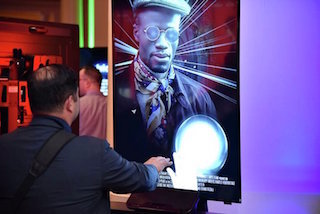 Already widely used in many industries such as automotive, healthcare, and smart homes, Ultrahaptics technology not only elevates the user experience, but also provides a safe and extraordinary interface for interacting with content. Now, this technology is improving the way patrons experience digital content in the cinema, increasing consumer dwell time and driving additional revenue opportunities via merchandising and concession sales.
Already widely used in many industries such as automotive, healthcare, and smart homes, Ultrahaptics technology not only elevates the user experience, but also provides a safe and extraordinary interface for interacting with content. Now, this technology is improving the way patrons experience digital content in the cinema, increasing consumer dwell time and driving additional revenue opportunities via merchandising and concession sales.
Under the arrangement, Cinionic provides the content creation and delivery expertise, derived from its exclusive relationships with studios, with Ultrahaptics supplying the technology platform and software to drive the user experience on the Barco Lobby Experience network.
“We are very excited about partnering with Cinionic, the leading-edge technical company in the cinema industry,” said Alex Driskill-Smith, vice president and general manager of Ultrahaptics North America. “Tactile feedback makes digital content more real and interactions more engaging. Mid-air haptics technology offers a natural and magical interface with movie content and our research indicates that this has the potential to add significant value to moviegoers and advertisers alike. It is a fantastic opportunity to transform the cinema lobby experience and make movie content and advertisements more engaging and memorable.”
ÉclairLive
ÉclairLive is dedicated to the screening of live events in cinemas across Europe via satellite and streaming. Acting on behalf of alternative content distributors, it allows the screening of more than 100 events every year. It uses its European network – 1,400 connected cinemas (8,000 screens) – equipped with professional receivers that can be managed and operated remotely, and installed directly in projection booths. The technology was introduced to the U.S. market at CinemaCon 2018.
 Éclair quietly launched the new technology with the successful first screening of a live event via streaming at the CGR cinema in Vitrolles, near Marseille (Bouches-du-Rhône). This first event of its kind featured the April 22 National Basketball Association playoffs match of the Golden State Warriors versus the San Antonio Spurs.
Éclair quietly launched the new technology with the successful first screening of a live event via streaming at the CGR cinema in Vitrolles, near Marseille (Bouches-du-Rhône). This first event of its kind featured the April 22 National Basketball Association playoffs match of the Golden State Warriors versus the San Antonio Spurs.
“We would like to thank CGR Events, specialized in the distribution of live event screenings for cinemas, for the trust they put in our EclairLive solution, which made this operation through broadband Internet possible," said Bruno d’Isidoro, business director for ÉclairLive at Éclair. “So far, the distribution of event cinema – concerts, opera, ballet, sports – was only possible via satellite transmission. Today, our streaming technology gives us more flexibility when it comes to alternative content distribution, and it guarantees an optimal image and sound quality for cinema exhibitors. Our ÉclairLive streaming solution allows content to be broadcast at a rate of between six and ten Megabits/s, which is the existing configuration in most cinemas in France. We hope that this new solution will allow distributors of alternative content to convince more exhibitors with the live event experience."
For Jocelyn Bouyssy, managing director of CGR Cinemas, " ÉclairLive, with its new live streaming capability, will allow us to expand the screening of alternative content in our cinemas. We will extend our content offer to meet the growing requests from our audiences, all without altering the image and sound quality.”
GDC Cinema Automation CA2.0
GDC’s Cinema Automation CA2.0 is the first centralized system to provide comprehensive automated management of content storage and playback, show scheduling, power supply and screening quality – providing exhibitors the best solution to save time, effort and cost. GDC CA2.0 incorporates SCL-2000 Centralized Storage Playback, an integrated centralized storage and playback system designed to streamline content management, and leverages machine intelligence to increase efficiency while dramatically reducing the need for human intervention.
 The automated system supports the ubiquitous SX-3000 and SX-4000 IMB and the new sixth generation SR-1000 IMB.
The automated system supports the ubiquitous SX-3000 and SX-4000 IMB and the new sixth generation SR-1000 IMB.
In addition, CA2.0 has the capability of storing up to 1,000 movies, offering near-unlimited show schedule programming options to as many as 14 screens from a centralized server, greatly increasing programming flexibility and eliminating the need for local storage.
The SCL-2000 marks three major breakthroughs:
Reduces content ingestion time by more than 90 percent
Increases playback reliability by 14 times
Stores more than 30 times more content for each and every auditorium
In addition to automating the complex procedure of manually preparing or editing show playlists, CA2.0 incorporates other advances. The system intelligently manages equipment power supply and assures screening quality automatically. Its sophisticated fail-safe design helps eliminating interruptions by ensuring that every screening continues undisturbed in the highly unlikely event of a central server failure
GDC GoGoCinema
GoGoCinema is the brainchild of Dr. Man-Nang Chong, founder and CEO of GDC Technology and an avid moviegoer who first envisioned the concept in 2012. While he thought the idea looked great on paper, but the technology did not exist to address the supply and demand challenges facing the theatrical distribution and exhibition industry.
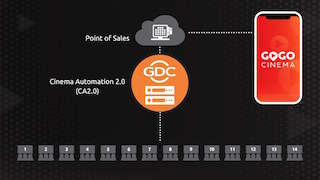 With the launch of GDC’s Cinema Automation CA2.0, he felt the timing was right to form GoGoCinema, a platform to support crowd-sourced screenings where movie lovers can choose from a library of 1,000 movies or more, and decide when and where they would like to watch their chosen movies.
With the launch of GDC’s Cinema Automation CA2.0, he felt the timing was right to form GoGoCinema, a platform to support crowd-sourced screenings where movie lovers can choose from a library of 1,000 movies or more, and decide when and where they would like to watch their chosen movies.
For consumers: The GoGoCinema platform allows moviegoers to select the movie, the cinema and the time of their choice. Moviegoers can select the movie by accessing a user-friendly and socially driven interface.
For exhibitors and content distributors: GoGoCinema is unique in its ability to help generate revenue at every stage of a movie title’s life cycle. Furthermore, the entire backend architecture is automated ensuring minimal or no human intervention. The GoGoCinema platform is designed to generate hugely untapped revenues for all stakeholders in theatrical exhibition and distribution.
“I am most passionate about seeing a movie on the big screen at a cinema," said Chong. “GoGoCinema is designed for the true movie lovers in the world with the same passion; it facilitates moviegoers to see movie of their choice in a big screen, at their preferred time and venue.”
Nagra myCinema
Long famed as a sound recording company, Nagra, a Kudelski Group company, has transformed itself into a digital content distribution and protection provider. It’s latest innovation, unveiled at CinemaCon, is myCinema, which the company calls “a ground-breaking service designed to transform the cinema experience.”
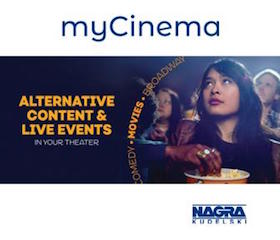 “We are partnering with theatre owners that are looking forward to growing their audience and maximizing venue utilization. As an Internet platform, myCinema enables diversified and flexible programming,” said André Kudelski, chairman of the board and chief executive officer, Kudelski Group. “Thanks to its AI-based analytics, myCinema identifies the unique fandoms active in a cinema’s local community and recommends targeted content choices. myCinema also features an app-based loyalty program tailored for each local cinema that allows consumers to express their programming wishes. Another key benefit is that myCinema significantly enhances image and sound quality, which are critical to drive people to the theatres.”
“We are partnering with theatre owners that are looking forward to growing their audience and maximizing venue utilization. As an Internet platform, myCinema enables diversified and flexible programming,” said André Kudelski, chairman of the board and chief executive officer, Kudelski Group. “Thanks to its AI-based analytics, myCinema identifies the unique fandoms active in a cinema’s local community and recommends targeted content choices. myCinema also features an app-based loyalty program tailored for each local cinema that allows consumers to express their programming wishes. Another key benefit is that myCinema significantly enhances image and sound quality, which are critical to drive people to the theatres.”
“Content creators will find in myCinema an internet platform that connects their valued creations to any theatre screen in a cost competitive way. This is a dramatic shift in the content distribution model, allowing theatres to screen a wide variety of content, including national interest or niche, recent or vintage and recorded or live,” Kudelski, added.
myCinema enables owners and operators to schedule and promote music events, sporting events, opera, ballet, Broadway, first-run independent film, re-releases of some of the best known and beloved film franchises, cinematic TV, eSports, content from around the globe, and more.
Samsung Onyx Cinema LED Screen
Available in variations extending between 16.4 feet in height and 33.8 feet in width, the Samsung Onyx Cinema LED Screen accommodates any venue configuration while delivering visual quality, technical performance and reliability beyond that of traditional projector-based operations. With the 4K model earning validation as the world’s first Digital Cinema Initiatives-certified theatre display, the Samsung Onyx translates the combination of advanced LED and high dynamic range picture quality to lifelike big screen content.
 “By aligning brilliant, uniform color presentation with LED picture quality and crystal-clear audio, the Samsung Onyx screen invites movie enthusiasts into the most immersive and memorable viewing arena available and repositions the theater as an entertainment haven,” said Seog-gi Kim, executive vice president of visual display business, Samsung Electronics. “We are thrilled to deliver a new and exciting theater experience to operators, managers and consumers around the world, and we look forward to working further with leading movie industry decision-makers to usher in the next generation of cinema.”
“By aligning brilliant, uniform color presentation with LED picture quality and crystal-clear audio, the Samsung Onyx screen invites movie enthusiasts into the most immersive and memorable viewing arena available and repositions the theater as an entertainment haven,” said Seog-gi Kim, executive vice president of visual display business, Samsung Electronics. “We are thrilled to deliver a new and exciting theater experience to operators, managers and consumers around the world, and we look forward to working further with leading movie industry decision-makers to usher in the next generation of cinema.”
Each Samsung Onyx screen features JBL Sculpted Surround sound from Harman’s JBL Professional brand, bringing scenes to life through clear and consistent audio. This integration enhances the listener experience while expanding the audio sweet spot within Onyx theaters, and ensures that all attendees can enjoy the same exceptional audio presentation regardless of seat location.
“JBL Professional’s legacy dates back to the infancy of talking motion pictures and has been at the forefront of the industry’s sound recording and amplification innovation for the past nine decades, twice earning Scientific and Technical Awards from the Academy of Motion Picture Arts and Sciences, making it the preferred brand for cinemas all over the world,” said Mohit Parasher, executive vice president of Harman and president of Harman professional solutions.
The 3D Onyx Cinema LED screen makes 3D movie content even more realistic through enhanced brightness and consistent color amplification. Glass-wearing viewers now can enjoy subtitle text, images and even minor visual details with unprecedented clarity and without the dark, blurry shadowing and potential dizziness that can occur in traditional 3D movie theatres.
Ymagis Group Hybrid Tone Mapping
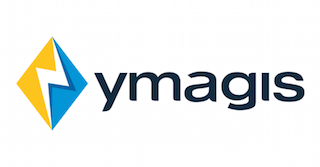 The number of versions that movie studios and other filmmakers must generate for widespread distribution is an ongoing challenge. This is the problem that the Ymagis Group addresses with its hybrid tone mapping technology, which enables the optimized storage of two or more versions – standard dynamic range and high dynamic range – of the same feature film in a single SMPTE-compliant digital cinema package.
The number of versions that movie studios and other filmmakers must generate for widespread distribution is an ongoing challenge. This is the problem that the Ymagis Group addresses with its hybrid tone mapping technology, which enables the optimized storage of two or more versions – standard dynamic range and high dynamic range – of the same feature film in a single SMPTE-compliant digital cinema package.
The patent-pending HTM system offers a multi-display multi-dynamic digital cinema package that comes with a special software, multi-dynamic mapping, that is easily integrated in projection systems through regular updates, as well as current or future LED displays. MD DCPs are fully compatible with all types of projection systems and LED cinema screens.
By incorporating specific settings in the DCP, the same content can be played via a standard projection system in SDR format as well as in HDR, whether the equipment is an EclairColor HDR-certified projector or simply HDR-ready. HTM technology allows the system to read the same group of files by automatically selecting the correct version of the film that matches the projection systems’ or existing LED displays’ technical specifications. Each version of the film gives filmmakers full artistic control over the content knowing that the HTM technology allows to combine an automatic adaption of the signal with the settings done by the color grader at the postproduction stage.
“The way distribution companies work today implies the multiplication of DCPs to adapt to the different screening environments of movie theaters, which is quite a constraint,” said Cédric Lejeune, vice president of technology and innovation at Eclair. “MD DCP offers a unique opportunity to assemble all versions of the same film on just one medium, one single DCP, without any [significant] increase in file size compared to a regular DCI DCP. This enhancement represents a great competitive advantage for both distributors and exhibitors. With this new, smart DCP, they can adopt HDR solutions like EclairColor HDR while simplifying the supply chain in a bold way. Without altering any aspect of the artistic choices made by the filmmaker or the director of photography, HDR and SDR versions are merged in an intelligent manner on one DCP. Movies can be projected from a single media fully compatible with the SMPTE standard and fit any type of existing display technology.”
“Today, for each film release, distributors need to provide hundreds of versions due to the various different technical and language versions,” said Jean Mizrahi, co-founder and president of Ymagis Group. “Thanks to Eclair's talented engineers, we are launching a singular smart solution that provides one DCP that is entirely compatible with projection system and LED display capabilities. The number of DCPs required is therefore greatly reduced. The HTM technology will facilitate the adoption of the HDR image in movie theaters. It can be used with both digital cinema projection systems installed at the beginning of the digital transition all the way to EclairColor-certified high contrast projection systems and EclairColor-certified high contrast LED Cinema Screens. With such flexibility, MD DCP paves the way to a flexible and staggered migration of movie theaters toward HDR technology.”
